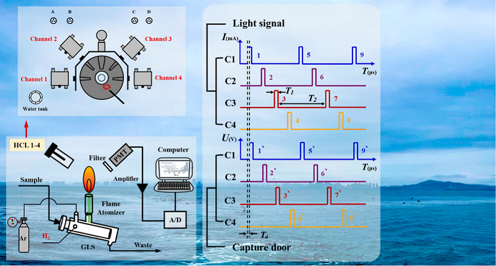Luodan Chen, Qinling Lin, Dongxing Yuan, and Zhenbin Gong*
Analytical Chemistry
Published: October 10, 2023
https://doi.org/10.1021/acs.analchem.3c02755
Abstract
Trace levels of Hg, As, Sb, and Bi in coastal seawater have been simultaneously detected by a laboratory-built multichannel chemical vapor generation coupled to an atomic fluorescence spectrometer. The system was configured with a built-in electrochemical H2 generator as the fuel supplier to replace chemical H2 produced by the oxidation of potassium borohydride under acidic conditions in traditional instruments. The electrochemical H2 generator not only isolated the atomization process from the chemical vapor injection process but also improved the stability of atomization, excitation, and fluorescence emission in the hydrogen flame, making it easier to optimize conditions for CVG while introducing evaporating multielement vapors. Calibrations were obtained using a mixed standard solution of Hg(II), As(III), Sb(III), and Bi(III). The addition of KBr to a 3% (v/v) HCl solution was selected as the preservative to ensure the stability of 0.10 μg/L Hg(II) in a multielement standard solution for at least 15 days while also preserving μg/L levels of As(III), Sb(III), and Bi(III) stable. The method detection limits (LOD, 3σ) were 0.001, 0.015, 0.010, and 0.005 μg/L for Hg, As, Sb, and Bi, respectively. The relative standard deviations (RSD, n = 7) of the standard spiked seawater samples were 3.2% (0.020 μg/L Hg), 1.2% (0.50 μg/L As), 1.0% (0.50 μg/L Sb), and 3.5% (0.050 μg/L Bi), respectively. The recoveries of seawater samples spiked with different salinities were in the range of 84.5%(Sb)–114%(Hg). The system has been successfully applied to the simultaneous analysis of the four elements in the seawater samples collected from Xiamen Bay, Southeast China.
